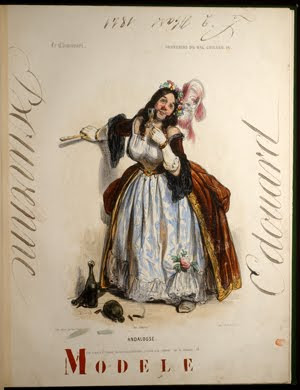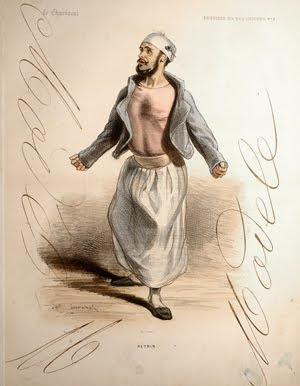 |
| Andalouse |
This past Tuesday, our friend L.D. Mitchell at The Private Library, discussed Hand-Colored Plates, paying particular attention to the assembly-line process required to manually color engravings or lithographs. The workers were, more often than not, anonymous women or children. The designers and engraver/lithographers did not color the plates themselves.
But these anonymous colorists were not left alone to improvise a palette, each of their own creation; they required a color scheme for reference. And these were not Venus Paradise Coloring Sets with numbers on the plate corresponding to a specific colored pencil. It was left to the original artist/designer or a primary colorist to create models for the workers to use as guides.
One such colorist/modeler was Edouard Bouvenne, an artist in his own right yet of whom little is known; he is not found in Benezit (now, thankfully, available in an English edition). But he often provided models for colorists employed by Chez Aubert and Chez Bauger, two of the leading publisher-printmakers in France, 1820-1845. Bouvenne was a "figure of considerable talent who was able to give strong coloration to certain of Daumier’s prints" (Fogle, Sabina. Daumier. L'écriture du lithographe. In Nineteenth Century Art Worldwide, Volume 7, Issue 2, Autumn 2008).
 |
| Pétrin |
Original models for hand-colored plates rarely survived their function; they were heavily used. From time to time, however, vintage hand-coloring models do surface and two years ago I had a set of them for Gavarni's Souvenirs du Bal Chicard pass through my hands, created by Bouvenne.
Second only to Daumier as the greatest social commentator and satirical artist of nineteenth century France, Gavarni produced the work under notice during his first period whence he confined himself to the study of Parisian manners, particularly those of the city's youth. Souvenirs du Bal Chicard (Memories of the Chicard Ball) dates from when he was in charge of the journal Le Charivari and was a regular at Paris's most prestigious balls, for which he often designed many costumes. During this time many of his finest lithographic sets drew their subject matter from these costume balls including Souvenirs du Bal Chicard.
 |
| Cacique |
“Costume balls had been a part of carnival celebrations in France since the fifteenth century, but their popularity was unprecedented during the period of the July Monarchy. At first private and aristocratic, they became increasingly popular among the new bourgeoisie and the aspiring lower classes when they could afford them. One of the more exclusive, expensive (fifteen francs), and licentious of these bal masqués was also one of the most popular. The Bal Chicard was given by a prosperous businessman, Alexandre Lévêque, who was called by the nickname Chicard. Gavarni was a friend of Chicard’s, and, as a result, was one of those regularly in attendance. In this image , from Souvenirs du Bal Chicard, a series of twenty lithographs published in Le Charivari between 1839 and 1843, we see one of the parodies of the earlier historic costumes of the bal masqué made famous at the Bal Chichard, along with some wilder forms of dancing...
 |
| Général Étranger |
"...In another image from the same series…Gavarni depicts an uninhibited dancer whose cap rests temporarily on the bottle of wine on the floor behind him. Gavarni’s intention here has obviously been to capture the character of the wild dancing for which the Bal Chicard was noted. In a pentimento, he has disguised a previously drawn extended arm by incorporating it into the drapery that flies off at the left, but it remains easy to visualize the figure with three arms. Gavarni not only drew the costumes he saw at the balls, but also designed costumes for use there. This troubadour’s costume purports to be a version of the late medieval doublet and hose, with anachronistic modifications frequently seen at the Bal Chicard, here emphasized by the pipe in the reveler’s mouth” (Beatrice Farwell, The Charged Image: French Lithographic Caricature 1816-1848, p. 86, 88).
Without Edouard Bouvenne's exquisite color models as a guide to assist the hand-colorists in bringing Gavarni's plates to life, who knows how these gorgeous plates would have turned out?
__________
GAVARNI . Souvenirs du Bal Chicard. .
A unique copy comprised of colorist Edouard Bouvenne's models. Large quarto (13 1/2 x 10 1/2 in; 341 x 266 mm). A suite of twenty hand colored lithographs representing the travesties of men and women, commissioned for Le Charivari. Printed by Aubert et Cie. All plates mounted on stubs.
Fourteen plates have "Modele" stenciled in color at foot; five have "Modele" inked in Bouvenne's hand and Bouvenne has boldly signed and dated thirteen plates; only the first plate is unmarked by Bouvenne in any way.
The plates: 1) Chicard. 2) Un Covage Civilizé. 3) Balochard. 4) Mr. Floumann. 5) Pétrin. 6) Commissaire de Marine. 7) Général Étranger. 8) Insulaire de n’importe où. 9) Troubadour. 10) Titi. 11) Agréable. 12) Cacique. 13) Emir. 14) Andalouse. 15) Triton. 16) Garde Champêtre. 7) Bourguemestre. 18) Robinson. 19) Minon-Minard 20) Pistolet.
Armelhaut and Boucher, L’Oeuvre de Gavarni, pp. 253, 524, and nos. 257 (“Chicard”) and 2280 (“Troubadour”). __________
Images courtesy of David Brass.

